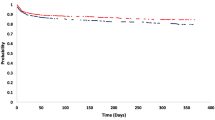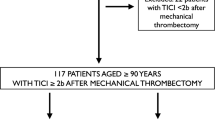Opinion statement
Advances in acute stroke therapy are rapidly changing our approach to the management of patients with ischemic stroke. Intravenous tissue plasminogen activator was the first treatment demonstrated in a randomized controlled trial to improve outcome if given within the first 3 hours of stroke onset. Subsequent trials failed to extend the time window for intravenous therapy beyond 3 hours. Intraarterial thrombolysis provides an alternative approach, with several advantages over intravenous therapy. The major drawback is the additional time needed for the interventional procedure, and the equipment and personnel requirements. New strategies aimed at reducing the total time from stroke onset to recanalization of occluded arteries include a combined intravenous/intra-arterial delivery of thrombolysis and mechanical devices. For the millions of stroke survivors, investigations are now underway into the possibility of improvement of function through neuronal transplantation.
Similar content being viewed by others
References and Recommended Reading
The National Institute of Neurological Disorders and Stroke rt-PA Stroke Study Group: Tissue plasminogen activator for acute ischemic stroke. N Engl J Med 1995, 333:1581–1587. First report of a randomized trial of acute stroke therapy showing significant improvement in outcome. Led to Food and Drug Administration approval of IV tPA for acute stroke.
Marler, JR, Tiller BC, Lu M, et al.: Early stroke treatment associated with better outcome: the NINDS rt-PA stroke study. Neurology 2000, 55:1649–1655. Demonstrated the importance of time-to-treatment in outcome after IV thrombolysis.
Steiner T, Bluhmki E, Kaste M, et al.: The ECASS 3-hour cohort. Secondary analysis of ECASS data by time stratification. Cerebrovasc Dis 1998, 8:198–203.
Alberts MJ: tPA in acute ischemic stroke: United States experience and issues for the future. Neurology 1998, 51:S53-S55.
Katzan IL, Furlan AJ, Lloyd LE, et al.: Use of tissue-type plasminogen activator for acute ischemic stroke: the Cleveland area experience. JAMA 2000, 283:1151–1158.
Meyer JS, Gilroy J, Barnhart MI, et al.: Anticoagulants plus streptokinase therapy in progressive stroke. JAMA 1963, 189:373.
Fletcher AP, Alkjaersig N, Lewis M, et al.: A pilot study of urokinase therapy in cerebral infarction. Stroke 1976, 7:135–142.
Meyer JS, Gilroy J, Barnhart MI, Johnson JF: Therapeutic thrombolysis in cerebral thromboembolism. Neurology 1963, 13:927–937.
Hacke W, Kaste M, Fieschi C, et al., for the ECASS Study Group: Intravenous thrombolysis with recombinant tissue plasminogen activator for acute hemispheric stroke. JAMA 1995, 274:1017–1025.
HackeW, Kaste M, Fieschi C, et al.: Randomized double-blind placebo-controlled trial of thrombolytic therapy with intravenous alteplase in acute ischemic stroke (ECASS II). Second European-Australasian Acute Stroke Study Investigators. Lancet 1998, 352:1245–1251. Large, well-designed randomized controlled trial of IV tPA for stroke up to 6 hours from onset. This trial did not confirm the benefit of IV tPA when attempting to extend the window of treatment to 6 hours, at least based on the primary prespecified end point.
Clark WM, Wissman S, Albers GW, et al.: Recombinant tissue-type plasminogen activator (Alteplase) for ischemic stroke 3–5 hours after symptom onset. The ATLANTIS Study: a randomized controlled trial. JAMA 1999, 21:2019–2026.
Hacke W, Brott T, Caplan L, et al.: Thrombolysis in acute ischemic stroke: controlled trials and clinical experience. Neurology 1999, 53:S3-S14. Excellent summary of clinical trials of IV thrombolysis with a new analysis based on poor outcomes.
The National Institue of Neurological Disorders and Stroke rt-PA Stroke Study Group: Generalized efficacy of t-PA for acute stroke. Subgroup analysis of the NINDS t-PA stroke trial. Stroke 1997, 28:2119–2125.
Tomsick TA, Brott TG, Barsan W, et al.: Prognostic value of the hyperdense middle cerebral artery sign and stroke scale score before ultraearly thrombolytic therapy. Am J Neuroradiol 1996, 17:79–85.
Wolpert SM, Brickmann H, Greenlee R, et al.: Neuroradiologic evaluation of patients with acute stroke treated with recombinant tissue plasminogen activator. The rt-PA acute stroke study group. Am J Neuroradiol 1993, 14:3–13.
Del ZoppoGJ, Higashida RT, Furlan AJ, et al., and the PROACT investigators: PROACT: a phase II randomized trial of recombinant pro-urokinase by direct arterial delivery in acute middle cerebral artery stroke. Stroke 1998, 29:4–11.
FurlanA, Higashida R, Wechsler L, et al.: Intra-arterial prourokinase for acute ischemic stroke. The PROACT II study: a randomized controlled trial. JAMA 1999, 282:2003–2011. Randomized controlled trial of IA thrombolysis for stroke within 6 hours of onset. This landmark study was the first to show a significant improvement in stroke outcome when treatment was initiated as late as 6 hours from onset of stroke, and the first to demonstrate the benefit of IA thrombolysis.
Wechsler L, Roberts R, Furlan A, et al.: Factors influencing outcome and treatment effect in PROACT II. Stroke 2001, 32:319.
Hornig CR, Buttner T, Hoffmann O, Dorndorf W: Short-term prognosis of vertebrobasilar ischemic stroke. Cerebrovasc Dis 1992, 2:273–281.
Hacke W, Zeumer H, Ferbert A, et al.: Intra-arterial thrombolytic therapy improves outcome in patients with acute vertebrobasilar occlusive disease. Stroke 1988, 19:1216–1222.
Zeumer N, Freitag H-J, Zanella F, et al.: Local intraarterial fibrinolytic therapy in patients with stroke: Urokinase versus recombinant tissue plasminogen activator (r-TPA). Neuroradiology 1993, 35:159–162.
Wijdicks EFM, Nichols DA, Thielen KR, et al.: Intraarterial thrombolysis in acute basilar artery thromboembolism: the initial Mayo Clinic experience. Mayo Clin Proc 1997, 72:1005–1013.
Zeumer H, Freitag HJ, Grzyka U, Neunzig HP: Local intra-arterial fibrinolysis in acute vertebrobasilar occlusion: technical developments and recent results. Neuroradiology 1989, 31:336.
Lewandowski CA, Frankel M, Tomsick TA, et al.: Combined intravenous and intra-arterial r-TPA versus intra-arterial therapy of acute ischemic stroke: Emergency Management of Stroke (EMS) Bridging Trial. Stroke 1999, 30:2598–2605. Small pilot study showing the potential of combined IV/IA thrombolysis.
Simon RP, Swan JH, Griffiths T, Meldrum BS: Blockade of N-methyl-D-aspartate receptors may protect against ischemic damage in the brain. Science 1984, 226:850–852.
Albers GW, Atkinson RP, Kelley RE, et al.: Safely, tolerability and pharmacokinetics of the N-methyl-D-aspartate antagonist dextrorphan in patients with acute stroke. Dextrorphan Study Group. Stroke 1995, 26:254–258.
Davis SM, Albers GW, Diener HC, et al.: Termination of acute stroke studies involving selfotal treatment. ASSIST steering committee. Lancet 1997, 349:32.
Diener HC, Cortens M, Ford G, et al.: Lubeluzole in acute ischemic stroke treatment: a double-blind study with an 8-hour inclusion window comparing a 10-mg daily dose of lubeluzole with placebo. Stroke 2000, 31:2543–2551.
Clark WM, Wechsler LR, Sabounjian LA, Schwiderski UE: A phase III randomized efficacy trial of 2000 mg citicoline in acute ischemic stroke patients. Neurology 2001, 57:1595–1602.
Johansson CB, Momma S, Clarke DL, et al.: Identification of a neural stem cell in the adult mammalian central nervous system. Cell 1999, 96:25–34.
Fricker RA, Carpenter MK, Winkler C, et al.: Site-specific migration and neural differentiation of human neural progenitor cells after transplantation in the adult rat brain. J Neurosci 1999, 19:5990–6005.
Sinden JD, Rashid-Doubell F, Kershaw TR, et al.: Recovery of spatial learning by grafts of a conditionally immortalized hippocampal neuroepithelial cell line into the ischemia-lesioned hippocampus. Neuroscience 1997, 81:599–608.
Chen J, Li Y, Chopp M: Intracerebral transplantation of bone marrow with BDNF after MCAo in rat. Neuropharmacology 2000, 39:711–716.
Chen J, Li Y, Wang L, et al.: Therapeutic benefit of intravenous administration of bone marrow stromal cells after cerebral ischemia in rats. Stroke 2001, 32:1005–1011.
Galpern WR, Burns LH, Deacon W, et al.: Xenotransplantation of porcine fetal ventral mesencephalon in a rat model of Parkinson’s disease: functional recovery and graft morphology. Exp Neurol 1996, 140:1–13.
Andrews PW, Damjanov I, Simon D, et al.: Pluripotent embryonal carcinoma clones derived from the human teratocarcinoma cell line Tera-2. Differentiation in vivo and in vitro. Lab Invest 1984, 50:147–162.
Andrews PW: Retinoic acid induces neuronal differentiation of a cloned human embryonal carcinoma cell line in vitro. Dev Biol 1984, 103:285–293.
Borlongan CV, Tajima Y, Trojanowski JQ, et al.: Transplantation of cryopreserved human embryonal carcinoma-derived neurons (NT2N cells) promotes functional recovery in ischemic rats. Exp Neurol 1998, 149:310–321.
Kleppner SR, Robinson KA, Trojanowski JQ, Lee VM-Y: Transplanted human neurons derived from a teratocarcinoma cell line (Nterra-2) mature, integrate, and survive for over 1 year in the nude mouse brain. J Comp Neurol 1995, 357:618–632.
Trojanowski JQ, Mantione JR, Lee LJ, et al.: Neurons derived from a teratocarcinoma cell line establish molecular and structural polarity following transplantation into a rodent brain. Exp Neurol 1993, 122:283–294.
Kondziolka D, Wechsler L, Goldstein S, et al.: Transplantation of cultured human neuronal cells for patients with stroke. Neurology 2000, 55:565–569. Results of a phase I study of neuronal transplantation. First report of human neuronal transplantation for stroke.
Meltzer CC, Kondziolka D, Villemagne VL, et al.: Serial [18F] fluorodeoxyglucose positron emission tomography after human neuronal implantation for stroke. Neurosurgery 2001, 49:586–591.
Author information
Authors and Affiliations
Rights and permissions
About this article
Cite this article
Wechsler, L.R. Innovative strategies in the management of acute stroke. Curr Treat Options Cardio Med 4, 421–428 (2002). https://doi.org/10.1007/s11936-002-0021-5
Issue Date:
DOI: https://doi.org/10.1007/s11936-002-0021-5




